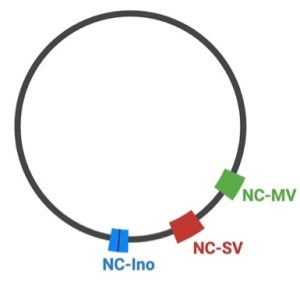School of Medicine
71 Adherent-Invasive E. Coli Siphovirus Prophage Excision is Induced During Murine Intestinal Colonization
Morgan Smoot; June Round; and Nicole Pershing
Faculty Mentor: Nicole Pershing (Pediatrics, University of Utah)
Background
Inflammatory Bowel Disease (IBD) is an autoimmune disorder characterized by inflammation of the intestinal tract. Imbalance in the bacterial or viral microbiome has been associated with IBD. Bacteriophages are viruses that infect bacteria, and prior work has shown bacteriophages can stimulate intestinal immune responses even in the absence of their bacterial host. 1 Bacteriophages in the gut can be produced when bacteriophage integrated into bacterial genomes, or prophage, are induced to excise from the bacterial genome and produce viruses. Determinants of prophage induction remain unknown. We sought to characterize excision of three identified prophages in an IBD-associated E. coli pathotype, Adherent Invasive Escherichia coli (AIEC), in mouse models of intestinal colonization and colitis.2
Methods
We utilized polymerase chain reaction (PCR) to screen bacterial colonies for integration and excision of three possible prophages identified in the NC101 AIEC genome: a Myoviridae (MV), a Siphoviridae (SV), and an Inoviridae (Ino) type bacteriophage. Colonies were screened from fecal and tissue samples from (i) germ-free mice monoassociated with NC101 and (ii) specific pathogen-free mice colonized with NC101 followed by induced colitis.

Figure 1 – Genomes of three intact putative prophage were identified in the E. coli NC101 bacterial genome.
Results
Following mouse gut colonization, we detected spontaneous excision of the SV prophage from the NC101 genome. No spontaneous excision of the NC-Ino or NC-MV prophages was identified. We did not observe significant differences in the rate of SV prophage excision between colonies screened during colonization versus colitis. To quantitatively assess prophage induction and identify bacteriophage abundance, we designed a quantitative polymerase chain reaction (qPCR) strategy to quantify bacterial genomes with integrated versus excised, and recirculated phage genomes for the Ino and MV phages; design of SV phage qPCRs is ongoing.
Conclusions
We have described spontaneous excision of the Siphovirus prophage from the AIEC strain NC101 during in vivo gut colonization of mice. Future directions characterizing AIEC prophage excision dynamics will utilize qPCR to quantitatively assess prophage induction following macrophage infection in vitro, and in vivo during gut colonization and intestinal inflammation.
References
1. Gogokhia, L., Round, J. PMC 2021
2. Pamela, C. et al. BMJ 2018;67:574-578

